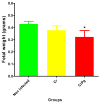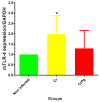Increased TLR4 expression in murine placentas after oral infection with periodontal pathogens
- PMID: 19101032
- PMCID: PMC2656361
- DOI: 10.1016/j.placenta.2008.11.017
Increased TLR4 expression in murine placentas after oral infection with periodontal pathogens
Abstract
Maternal periodontitis has emerged as a putative risk factor for preterm births in humans. The periodontitis-associated dental biofilm is thought to serve as an important source of oral bacteria and related virulence factors that hematogenously disseminate and affect the fetoplacental unit; however the underlying biological mechanisms are yet to be fully elucidated. This study hypothesized that an oral infection with the human periodontal pathogens Campylobacter rectus and Porphyromonas gingivalis is able to induce fetal growth restriction, placental inflammation and enhance Toll-like receptors type 4 (TLR4) expression in a murine pregnancy model. Female Balb/C mice (n = 40) were orally infected with C. rectus and/or P. gingivalis over a 16-week period and mated once/week. Pregnant mice were sacrificed at embryonic day (E) 16.5 and placentas were collected and analyzed for TLR4 mRNA levels and qualitative protein expression by real-time PCR and immunofluorescence. TLR4 mRNA expression was found to be increased in the C. rectus-infected group (1.98 +/- 0.886-fold difference, P < 0.01, ANOVA) compared to controls. Microscopic analysis of murine placentas showed enhanced immunofluorescence of TLR4 in trophoblasts, mainly in the placental labyrinth layer. Also, combined oral infection with C. rectus and P. gingivalis significantly reduced the overall fecundity compared to controls (16.7% vs. 75%, infected vs. non-infected mice respectively, P = 0.03, Kaplan-Meier). The results supported an enhanced placental TLR4 expression after oral infection with periodontal pathogens. The TLR4 pathway has been implicated in the pathogenesis of preterm births; therefore the abnormal regulation of placental TLR4 may give new insights into how maternal periodontitis and periodontal pathogens might be linked to placental inflammation and preterm birth pathogenesis.
Figures





References
-
- Report of a WHO Expert Committee. The prevention of perinatal mortality and morbidity. World Health Organ Tech Rep Ser. 1970;457:1–60. - PubMed
-
- McCormick MC. The contribution of low birth weight to infant mortality and childhood morbidity. N Engl J Med. 1985 Jan 10;312(2):82–90. - PubMed
-
- Romero R, Mazor M, Munoz H, Gomez R, Galasso M, Sherer DM. The preterm labor syndrome. Ann N Y Acad Sci. 1994 Sep 30;734:414–29. - PubMed
-
- Shoji T, Yoshida S, Mitsunari M, Miyake N, Tsukihara S, Iwabe T, Harada T, Terakawa N. Involvement of p38 MAP kinase in lipopolysaccharide-induced production of pro- and anti-inflammatory cytokines and prostaglandin E(2) in human choriodecidua. J Reprod Immunol. 2007 Oct;75(2):82–90. - PubMed
Publication types
MeSH terms
Substances
Grants and funding
LinkOut - more resources
Full Text Sources
Medical

